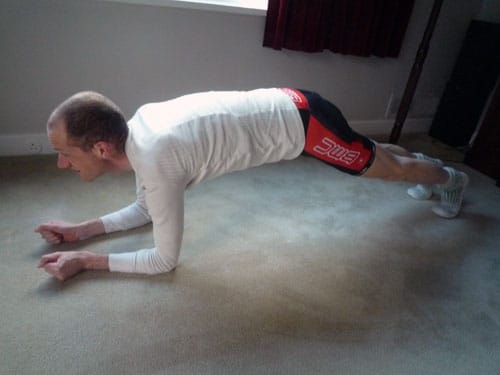Over the years I’ve gleaned a few bits from Cycling Weekly’s training advice. One thing they always seem to go on about is ‘core strength’ i.e. making the lower and middle body stronger to hold a good position when cycling. I’ve never paid too much attention to this aspect of cycling. I’ve always leaned to the more ‘Obree’ approach of relying on just riding the bike. However, after having spent quite a few hours on the bike in the past few weeks, I’ve felt ‘core strength’ really is important. Last week, I did two big rides – one very hilly on a road bike, and another four hour ride on my time trial bike. On both rides, the most difficult thing was the pain in lower back and neck.
In Cycling Weekly this week, they said the most common reason for abandoning the ‘Race Across America RAAM)’ was discomfort in the back and neck, and if riders had a second chance, they would have done more core strength training to improve their chances of staying on the bike.
Another thing which I noticed last week, was watching a recent time trial in the Criterium Dauphine. Contador looked all over the place – wiggling from one side to the other. (Contador would probably benefit from using a Kask Bambino – his aero helmet always seemed to be pointing to the stars creating a lot of drag) A smooth position, where riders can hold their body constant is generally considered more efficient.
There’s nothing worse than being really well prepared for a ride, and then struggling – not due to a lack of fitness or your legs aren’t strong enough, but because your back can’t take it.
Admittedly, most cyclists won’t be worrying about trying to do 4+ hours on a time trial bike, but, even on a road bike – especially if it’s hilly, you work your back much more than you might imagine.
Reasons to do core strength training
- Improved comfort. Important for longer rides
- Less distracting having to deal with back and neck pain.
- Strength in core muscles, provides stronger leverage for when you pedal.
- Increases ability to hold aerodynamic position for longer.
- Cycling doesn’t just use legs. Try climb a steepish climb whilst seated in the saddle and feel all the muscles in your back and shoulders being utilised.
- Although cycling relies on core strength to hold the cycling position, it doesn’t really build it.
I suppose, their might be a slight disadvantage of extra weight in the upper body, but I don’t think this extra muscle weight will be too significant compared to the benefits.
Also, if you have only a short time frame for cycling (e.g. 8 hours a week), and you tend to do short races, like 1 – 2 hours, then you will probably benefit from spending all those 8 hours cycling. But, core strength exercises are something that you can do on rest and recovery days.
Exercises for core strength.
Sit ups. The simple sit up, works the lower back well, and is a good exercise
The Plank.
Just holding a flat back, like this position (though back should be straighter than me) will work a lot of muscles, used when cycling.
The crunch
- Lye on your back with legs bent and feet shoulder width apart
- Place hands on your thighs. Lift your body, until your hands are touching the top of your knee.
- Keep the back flat on the floor so there is no arch.
- The movement is small to protect the lower back; this area should be kept in neutral or pressed into the floor so it does not over arch
- Threes sets of 25-30 repetitions with 30-60 seconds rest between sets would be a good starting point
Power Bridge
A. Lying on your back, bend your knees and place your heels near your glutes. Arms are at your sides, palms down.
B. In one smooth motion, squeeze your glutes, raise your hips off the floor and push up from your heels to form a straight line from shoulders to knees; toes come off the floor slightly. Hold for two seconds. Keeping your toes raised, lower yourself three-quarters of the way to complete one rep. Do 20 repetitions.
Boat Pose
A. Sit, resting both hands lightly behind you, and lean back until your torso is at a 45-degree angle
B. Keeping your legs together, lift them off the floor as you extend arms forward at shoulder height. Abs are tight, as thighs and torso form a 90-degree angle. If your hamstrings are tight, you’ll need to bend your knees a little. Work up to holding for 60 seconds.
see: more Core strength)
Other exercises
- Core strength exercises by Jamie Staff
In addition to core strength
In addition to core strength exercises, there are other things which can make for a more comfy ride.
Check your position, e.g. if you are too stretched out, you place too much strain on your back. I recently bought a shorter stem for my road bike to make position more comfortable.
When riding, don’t wait until the pain in the back starts. For longer rides, have the discipline to change position every half an hour or so and relieve some pressure.
Related


1 thought on “Core strength cycling”